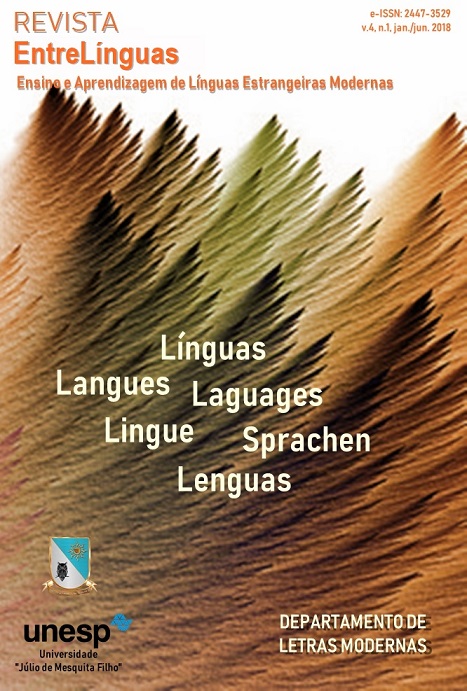Interculturality and spanish language variations in a school of the frontier Brazil/Venezuela
DOI:
https://doi.org/10.29051/rel.v4.n1.2018.11175Keywords:
Interculturality, Linguistic variation, Spanish, Border.Abstract
This research was carried out in the rooms of the last years of high school at the Cícero Viera Neto State School, located in the municipality of Pacaraima-Roraima-Brazil, in order to investigate how interculturality is approached as well as the linguistic variations of the Spanish language in this area. institution. We analyze the problems that lead to not working the linguistic and cultural diversities that characterize Spanish. The methodological base that supported the research was the qualitative approach and the field study. As results we show that intercultural activities happen little in school, despite being an environment rich in diversity. The linguistic variation that is worked on in Spanish classes is peninsular, without concern for the linguistic reality of students and the border region.
Downloads
References
BRASIL. Secretaria de Educação Fundamental. Parâmetros Curriculares Nacionais: Língua Estrangeira. Brasília: MEC/SEF, 1998.
FLEURI, R. M. Desafios à educação intercultural no Brasil. Revista PerCursos, n. 1, p. 109-128, 2001.
FLEURI, R. M. (Org). Educação Intercultural: mediações necessárias. Rio de Janeiro: DP&A, 2003.
HARO, H.; VELEZ, C. La interculturalidad en la reforma curricular: de la protesta a la propuesta. Memorias de los talleres de antropología aplicada. Quito, Universidad Politécnica Salesiana, 1997.
MORENO F. F. El modelo de la lengua y la variación lingüísti¬ca. In: LOBATO, J. Sánchez.; GARGALLO, I. Santos. (dir.). Vademécum para la forma¬ción de profesores. Enseñar español como segunda lengua (L2)/lengua extran¬jera (LE), Madrid: SGEL, 2004.
MORENO F. F. Las variedades de la lengua Española y su enseñanza. In Manuales de formación de profesores de Español 2/L. Editora. Arco/Libros, pg. 9- 164. Madrid, 2010.
PARAQUETT, M. Multiculturalismo, interculturalismo e ensino/aprendizagem de espanhol para brasileiros. In: BARROS, C.; COSTA, E. G. M. (Org) Espanhol: ensino médio. Brasília: Ministério da Educação, Secretaria de Educação Básica, 2010. p. 137-155.
SOUZA, M. I. P. de.; FLEURI, R. M. Entre límites e limiares de culturas: educação na perspectiva intercultural. In: FLEURI, R. M. (org.). Educação intercultural: mediações necessárias. Rio de Janeiro: DP&A, 2003. p. 53-84.
SPEISER, Sabine. El para qué la interculturalidad en la educación. In: MOYA, Ruth. (Sinopsis) La Interculturalidad y la Educación: Diálogo para la Democracia en América Latina. 1. ed. Quito/Ecuador. ed. Ruht Moya, 1999.
WALSH C. Qué es la interculturalidad y cuál es su significado e importancia en el proceso educativo? En: La Interculturalidad en la educación. Lima, Ministerio de Educación, Dirección Nacional de Educación Bilingüe Intercultural, 2005. p. 4-7.
Downloads
Published
How to Cite
Issue
Section
License
Os manuscritos aceitos e publicados são de propriedade da Revista EntreLínguas. Os artigos publicados e as referências citadas na Revista EntreLínguas são de inteira responsabilidade de seus autores.
Transferência de direitos autorais – autorização para publicação
Caso o artigo submetido seja aprovado para publicação, já fica acordado que o(s) autor(es) autoriza(m) a UNESP a reproduzi-lo e publicá-lo na EntreLínguas, entendendo-se os termos “reprodução” e “publicação” conforme definição respectivamente dos incisos VI e I do artigo 5° da Lei 9610/98. O artigo poderá ser acessado pela rede mundial de computadores (Internet), sendo permitidas, a título gratuito, a consulta e a reprodução de exemplar do artigo para uso próprio de quem a consulta, desde que haja a citação ao texto consultado. Essa autorização de publicação 328 EntreLínguas, Araraquara, v. 1, n .2, p. 323-328, jul./dez. 2015 não tem limitação de tempo, ficando a UNESP responsável pela manutenção da identificação do(s) autor(es) do artigo. Os artigos publicados e as referências citadas na Revista EntreLínguas são de inteira responsabilidade de seus autores.











